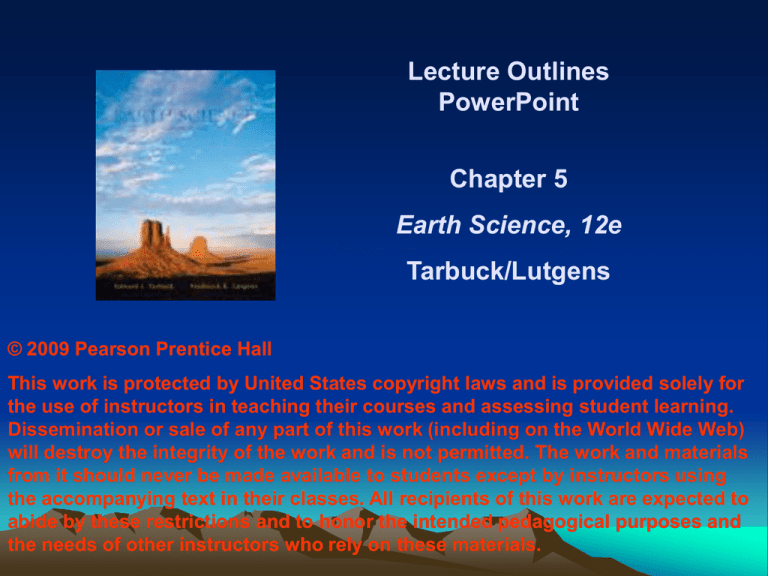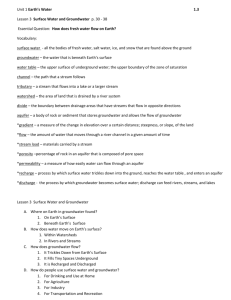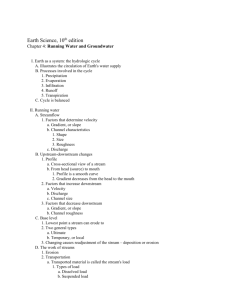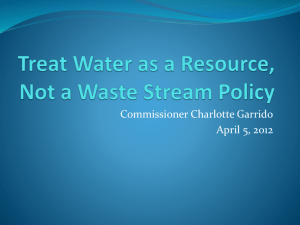
Lecture Outlines
PowerPoint
Chapter 5
Earth Science, 12e
Tarbuck/Lutgens
© 2009 Pearson Prentice Hall
This work is protected by United States copyright laws and is provided solely for
the use of instructors in teaching their courses and assessing student learning.
Dissemination or sale of any part of this work (including on the World Wide Web)
will destroy the integrity of the work and is not permitted. The work and materials
from it should never be made available to students except by instructors using
the accompanying text in their classes. All recipients of this work are expected to
abide by these restrictions and to honor the intended pedagogical purposes and
the needs of other instructors who rely on these materials.
Earth Science,
12e
Running Water and
Groundwater
Chapter 5
Earth as a system: the
hydrologic cycle
Illustrates the circulation of Earth’s water
supply
Processes involved in the cycle
•
•
•
•
•
Precipitation
Evaporation
Infiltration
Runoff
Transpiration
The hydrologic cycle
Figure 5.3
Sources of Earth’s water
Figure 5.2
Running water
Drainage basin
• Land area that contributes water to a river
system
• A divide separates drainage basins
Drainage basins and
drainage divides
Figure 5.4
Running water
Streamflow
• Factors that determine velocity
• Gradient, or slope
• Channel characteristics
• Shape
• Size
• Roughness
• Discharge – volume of water flowing in the stream
(generally expressed as cubic feet per second)
Running water
Upstream-downstream changes
• Profile
• Cross-sectional view of a stream
• From head (source) to mouth
• Profile is a smooth curve
• Gradient decreases from the head to the mouth
• Factors that increase downstream
• Velocity
• Discharge
Running water
Upstream-downstream changes
• Profile
• Factors that increase downstream
• Channel size
• Factors that decrease downstream
• Gradient, or slope
• Channel roughness
Longitudinal profile
of a stream
Figure 5.7
Running water
The work of streams
• Erosion
• Transportation
• Transported material is called the stream’s load
• Dissolved load
• Suspended load
• Bed load
Running water
The work of streams
• Transportation
• Load is related to a stream’s
• Competence – maximum particle size
• Capacity – maximum load
• Capacity is related to discharge
Running water
The work of streams
• Transportation
• Deposition
• Caused by a decrease in velocity
• Competence is reduced
• Sediment begins to drop out
• Stream sediments
• Known as alluvium
• Well-sorted deposits
Running water
The work of streams
• Transportation
• Features produced by deposition
• Deltas – exist in ocean or lakes
• Natural levees – Form parallel to the stream
channel
• Area behind the levees may contain
backswamps or yazoo tributaries
Formation of natural levees
by repeated flooding
Figure 5.21
Running water
Base level
• Lowest point to which a stream can erode
• Two general types
• Ultimate – sea level
• Temporary, or local
• Changing causes readjustment of the stream
– deposition or erosion
Adjustment of base level
to changing conditions
Figure 5.15
Running water
Stream valleys
• Valley sides are shaped by
• Weathering
• Overland flow
• Mass wasting
• Characteristics of narrow valleys
• V-shaped
• Downcutting toward base level
Running water
Stream valleys
• Characteristics of narrow valleys
• Features often include
• Rapids
• Waterfalls
• Characteristics of wide valleys
• Stream is near base level
• Downward erosion is less dominant
• Stream energy is directed from side to side
A narrow, V-shaped valley
Figure 5.17 A
Continued erosion and
deposition widens the valley
Figure 5.17 B
A wide stream valley is
characterized by meandering on
a well-developed floodplain
Figure 5.17 C
Running water
Stream valleys
• Characteristics of wide valleys
• Floodplain
• Features often include
• Meanders
• Cutoffs
• Oxbow lakes
Erosion and deposition along
a meandering stream
Figure 5.10
A meander loop on the
Colorado River
Figure 5.18
Formation of
a cutoff and
oxbow lake
Figure 5.11
Running water
Drainage patterns
• Networks of streams that form distinctive
patterns
• Types of drainage patterns
•
•
•
•
Dendritic
Radial
Rectangular
Trellis
Drainage patterns
Figure 5.22
Running water
Floods and flood control
• Floods are the most common geologic hazard
• Causes of floods
• Weather
• Human interference with the stream system
Running water
Floods and flood control
• Engineering efforts
• Artificial levees
• Flood-control dams
• Channelization
• Nonstructural approach through sound
floodplain management
Satellite view of the Missouri
River flowing into the
Mississippi River near St. Louis
Figure 5.23 top
Same satellite view during
flooding in 1993
Figure 5.23 bottom
Water beneath the
surface (groundwater)
Largest freshwater reservoir for humans
Geological roles
• As an erosional agent, dissolving by
groundwater produces
• Sinkholes
• Caverns
• An equalizer of streamflow
Water beneath the
surface (groundwater)
Distribution and movement of groundwater
• Distribution of groundwater
• Belt of soil moisture
• Zone of aeration
• Unsaturated zone
• Pore spaces in the material are filled mainly
with air
Water beneath the
surface (groundwater)
Distribution and movement of groundwater
• Distribution of groundwater
• Zone of saturation
• All pore spaces in the material are filled with
water
• Water within the pores is groundwater
• Water table – the upper limit of the zone of
saturation
Features associated with
subsurface water
Figure 5.26
Water beneath the
surface (groundwater)
Distribution and movement of
groundwater
• Distribution of groundwater
• Porosity
• Percentage of pore spaces
• Determines storage of groundwater
• Permeability
• Ability to transmit water through connected
pore spaces
• Aquitard – an impermeable layer of material
• Aquifer – a permeable layer of material
Water beneath the
surface (groundwater)
Features associated with groundwater
• Springs
• Hot springs
• Water is 6–9°C warmer than the mean air
temperature of the locality
• Heated by cooling of igneous rock
• Geysers
• Intermittent hot springs
• Water turns to steam and erupts
Old Faithful geyser in
Yellowstone National Park
Figure 5.29
Water beneath the
surface (groundwater)
Features associated with groundwater
• Wells
• Pumping can cause a drawdown (lowering) of
the water table
• Pumping can form a cone of depression in the
water table
• Artesian wells
• Water in the well rises higher than the initial
groundwater level
Formation of a cone of
depression in the water table
Figure 5.31
Artesian systems
Figure 5.32
Water beneath the
surface (groundwater)
Environmental problems associated
with groundwater
• Treating it as a nonrenewable resource
• Land subsidence caused by its withdrawal
• Contamination
Water beneath the
surface (groundwater)
Geologic work of groundwater
• Groundwater is often mildly acidic
• Contains weak carbonic acid
• Dissolves calcite in limestone
• Caverns
• Formed by dissolving rock beneath Earth’s
surface
• Formed in the zone of saturation
Water beneath the
surface (groundwater)
Geologic work of groundwater
• Caverns
• Features found within caverns
• Form in the zone of aeration
• Composed of dripstone
• Calcite deposited as dripping water
evaporates
• Common features include stalactites
(hanging from the ceiling) and stalagmites
(growing upward from the floor)
Cave Features in Lehman Caves, Great
Basin National Park, and Carlsbad
Caverns National Park
Figure 5.38
Water beneath the
surface (groundwater)
Geologic work of groundwater
• Karst topography
• Formed by dissolving rock at, or near, Earth’s
surface
• Common features
• Sinkholes – surface depressions
• Sinkholes form by dissolving bedrock and
cavern collapse
• Caves and caverns
• Area lacks good surface drainage
Features of karst
topography
Figure 5.39 C
End of Chapter 5









